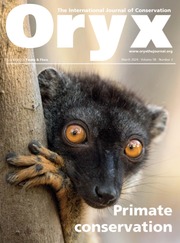Crossref Citations
This article has been cited by the following publications. This list is generated based on data provided by Crossref.
Rashid, Wajid
Shi, Jianbin
Rahim, Inam ur
Qasim, Muhammad
Baloch, Muhammad Naveed
Bohnett, Eve
Yang, Fangyuan
Khan, Imran
and
Ahmad, Bilal
2021.
Modelling Potential Distribution of Snow Leopards in Pamir, Northern Pakistan: Implications for Human–Snow Leopard Conflicts.
Sustainability,
Vol. 13,
Issue. 23,
p.
13229.
Zhang, Yu
Dai, Yunchuan
Li, Jia
Cong, Wei
Zhang, Yuguang
Nie, Xiuqing
Wu, Qiong
and
Xue, Yadong
2025.
Climate Change and Human Pressure: Assessing the Vulnerability of Snow Leopard (Panthera uncia) Habitat Integrated With Prey Distribution on the Qinghai‐Tibet Plateau.
Ecology and Evolution,
Vol. 15,
Issue. 4,


The elusive snow leopard remains an enigma—highly threatened yet difficult to study. Even dedicated snow leopard researchers rarely, if ever, glimpse the species other than in camera-trap photographs. Despite this—or perhaps in part because of it—the species is a conservation flagship for Asia's high mountains.
Yet despite the challenges of studying such a rare felid in a harsh environment, a growing body of research, much of it published in Oryx, is improving our knowledge of this apex predator (e.g. Hussain, Reference Hussain2003; Mishra & Fitzherbert, Reference Mishra and Fitzherbert2004; Ale et al., Reference Ale, Yonzon and Thapa2007; Xu et al., Reference Xu, Jiang, Li, Guo, Da and Cui2008; Jumabay-Uulu et al., Reference Jumabay-Uulu, Wegge, Mishra and Sharma2014; Alexander et al., Reference Alexander, Cusack, Pengju, Kun and Riordan2016a,Reference Alexander, Shi, Tallents and Riordanb; Taubmann et al., Reference Taubmann, Sharma, Uulu, Hines and Mishra2016; Tumursukh et al., Reference Tumursukh, Suryawanshi, Mishra, McCarthy and Boldgiv2016). Five articles in this issue further examine the species’ distribution and conservation status.
Circa 60% of the global snow leopard habitat lies in China. In the high altitudes of Yunnan, at the edge of the species’ range, herders and reserve officials report snow leopards are present, but if they are they are extremely rare, as camera-trapping failed to find them despite the presence of suitable prey (Buzzard et al., Reference Buzzard, Xueyou and Bleisch2017b). In contrast, in Qomolangma National Nature Reserve (Chen et al., Reference Chen, Gao, Wang, Pu, Lhaba and Hu2017) and in the Tienshan Mountains (Buzzard et al., Reference Buzzard, MaMing, Turghan, Xiong and Zhang2017a), snow leopards appear to be more common.
Community-based trophy hunting for prey species such as ibex and argali is a potential conservation initiative for the snow leopard. A comparison of the densities of the snow leopard and its prey in a hunting concession and an otherwise comparable unmanaged area, in Tajikistan, revealed higher levels of ungulates in the concession (Kachel et al., Reference Kachel, McCarthy, McCarthy and Oshurmamadov2017), although the subject needs further investigation.
Not content with being elusive, the snow leopard is also controversial. Mallon & Jackson (Reference Mallon and Jackson2017) suggest, based on a compilation of research, that the status of the snow leopard is less dire than previously thought. They outline a case for changing the species’ IUCN Red List status to a lower category of threat, from Endangered to Vulnerable. They also note this has met with opposition amongst some researchers. This is unsurprising, as only an insignificant proportion of the species’ vast range has as yet been surveyed using scientifically acceptable techniques.
Despite its fame, the snow leopard is a victim of intensifying poaching and illegal trade, and retaliation as a result of livestock predation. Sitting on the roof of the world, the species is also threatened by climate change. New studies are throwing light on this enigmatic species but, to use a hackneyed phrase—further research is still needed.
This Commentary and references cited herein are freely available as a virtual issue of the journal at http://www.cambridge.org/core.